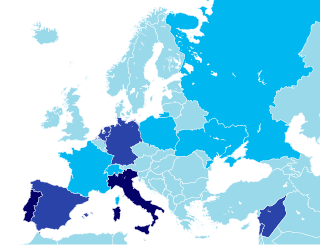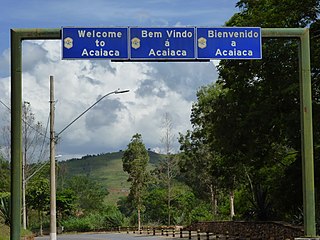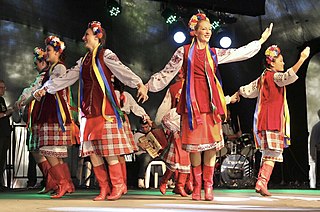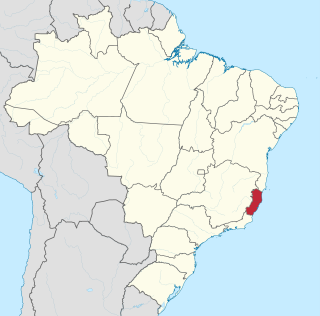Related Research Articles

Demographic features of the population of Portugal include population density, ethnicity, education level, health of the populace, economic status, religious affiliations and other aspects of the population.

Minas Gerais is one of the 27 federative units of Brazil, being the fourth largest state by area and the second largest in number of inhabitants with a population of 20,539,989 according to the 2022 census. Located in the Southeast Region of the country, it is bordered to south and southwest by São Paulo; Mato Grosso do Sul to the west; Goiás and the Federal District to the northwest; Bahia to the north and northeast; Espírito Santo to the east; and Rio de Janeiro to the southeast. The state's capital and largest city, Belo Horizonte, is a major urban and finance center in Brazil, being the sixth most populous municipality in the country while its metropolitan area ranks as the third largest in Brazil with just over 5.8 million inhabitants, after those of São Paulo and Rio de Janeiro. Minas Gerais' territory is subdivided into 853 municipalities, the largest number among Brazilian states.

Ouro Preto, formerly Vila Rica, is a Brazilian municipality located in the state of Minas Gerais. The city, a former colonial mining town located in the Serra do Espinhaço mountains, was designated a World Heritage Site by UNESCO due to its Baroque colonial architecture. Ouro Preto used to be the capital of Minas Gerais from 1720 until the foundation of Belo Horizonte in 1897.

Petrópolis, also known as the Imperial City, is a municipality in the Southeast Region of Brazil. It is located in the state of Rio de Janeiro, 68 kilometres (42 mi) northeast of the city of Rio de Janeiro. According to the 2022 Brazilian census, Petrópolis municipality had a population of 278,881 inhabitants. Besides being the largest and most populous city in the Fluminense Mountain Region, the city also has the largest GDP and HDI in the region.

German Brazilians refers to Brazilians of full or partial German ancestry. German Brazilians live mostly in the country's South Region, with a smaller but still significant percentage living in the Southeast Region.

Diamantina is a Brazilian municipality in the state of Minas Gerais. Its estimated population in 2020 was 47,825 in a total area of 3,870 km2.

The Brazilian Highway System is a network of trunk roads administered by the Ministry of Transport of Brazil. It is constructed, managed and maintained by the National Department of Transport Infrastructure (DNIT), a federal agency linked to the Ministry of Infrastructure, and the public works departments of state governments.

Andrelândia is a Brazilian municipality in the state of Minas Gerais that is located in the Mesoregion of South and Southwest of Minas and hosts the Microregion of Andrelândia. It is 300 km away from the state capital, Belo Horizonte and occupies an area of approximately 1 005 km2. In 2014 its population was estimated at 12 507 inhabitants, being the 296th most populous municipality in the state of Minas Gerais and the second of its microregion.
The German-based varieties spoken by German Brazilians together form a significant minority language in Brazil. "Brazilian German" is strongly influenced by Portuguese and to a lesser extent by Italian dialects as well as indigenous languages. High German and Low Saxon/German dialects and Germanic languages are particularly strong in Brazil's South and Southeast Regions.

Immigration to Brazil is the movement to Brazil of foreign peoples to reside permanently. It should not be confused with the forcible bringing of people from Africa as slaves. Latin Europe accounted for four-fifths of the arrivals. This engendered a strikingly multicultural society. Yet over a few generations, Brazil absorbed these new populations in a manner that resembles the experience of the rest of the New World.

Leopoldina is a Brazilian municipality in the state of Minas Gerais. It belongs to the Zona da Mata mesoregion and it located 322 kilometers southeast of Belo Horizonte, the state capital. In 2022, its estimated population was 51 145 inhabitants, according to IBGE. Its territory covers an area of 943 km2.
East Pomeranian or Farther Pomeranian is an East Low German dialect moribund in Europe, which used to be spoken in the region of Farther Pomerania when it was part of the German Province of Pomerania, until World War II, and today is part of Poland. Currently, the language survives mainly in Brazil, where it is spoken by descendants of German immigrants of the 19th century and where it was given its own script by the linguist Ismael Tressmann. It has co-official status in 11 Brazilian municipalities and has been recognized as a historical and cultural heritage of the Brazilian state of Espírito Santo. East Pomeranian is also spoken in central Wisconsin and parts of Iowa, in the United States.

Portuguese is the official and national language of Brazil, being widely spoken by nearly all of its population. Brazil is the most populous Portuguese-speaking country in the world, with its lands comprising the majority of Portugal's former colonial holdings in the Americas.

Czech Brazilians refer to Brazilians of Czech descent who were born in or who trace their ancestry to the territory of the historic Czech lands or succession states, now known as the Czech Republic, and are residents or citizens of Brazil.

The languages of South America can be divided into three broad groups:

Russian Brazilians are Brazilian citizens of full or partial Russian ethnic background or Russian-born people residing in Brazil. The term can also refer to someone with a Brazilian mother and Russian father, or vice versa.

Minas Novas is a municipality in the northeast of the Brazilian state of Minas Gerais. In 2020, the population was 31,497 in a total area of 1,810 km². The elevation of the urban area is 635 meters. It is part of the IBGE statistical meso-region of Jequitinhonha and the micro-region of Capelinha. It became a municipality in 1730.

Espírito Santo is a state in southeastern Brazil. Its capital is Vitória, and its largest city is Serra. With an extensive coastline, the state hosts some of the country's main ports, and its beaches are significant tourist attractions.
Neitzel is a surname. Notable people with the surname include:
Vila Velha do Cassiporé is a village and district in the Brazilian municipality of Oiapoque, Amapá. It is located on the Cassiporé River. Vila Velha is in a protected area near the Cabo Orange National Park. In 2016, it was recognised as a Quilombo settlement.
References
- ↑ Descendentes de etnia germânica vivem isolados em área rural de Minas
- ↑ Fundação vai ajudar pomeranos a desenvolver projetos sociais
- ↑ Pomeranos em busca de recursos federais [ dead link ]
- ↑ Descendentes de etnia germânica vivem isolados em área rural de Minas
- ↑ Nova Itueta pode virar moradia de crianças e velhos [ permanent dead link ]
- ↑ Resistência cultural - Imigrantes que buscaram no Brasil melhores condições de vida, ficaram isolados e sem apoio do poder público Archived November 20, 2015, at the Wayback Machine , acessado em 2 November 2011
- ↑ "Pommern in Brasilien - LernCafe – Online-Journal zur allgemeinen Weiterbildung". Archived from the original on 2017-10-10. Retrieved 2017-07-27.